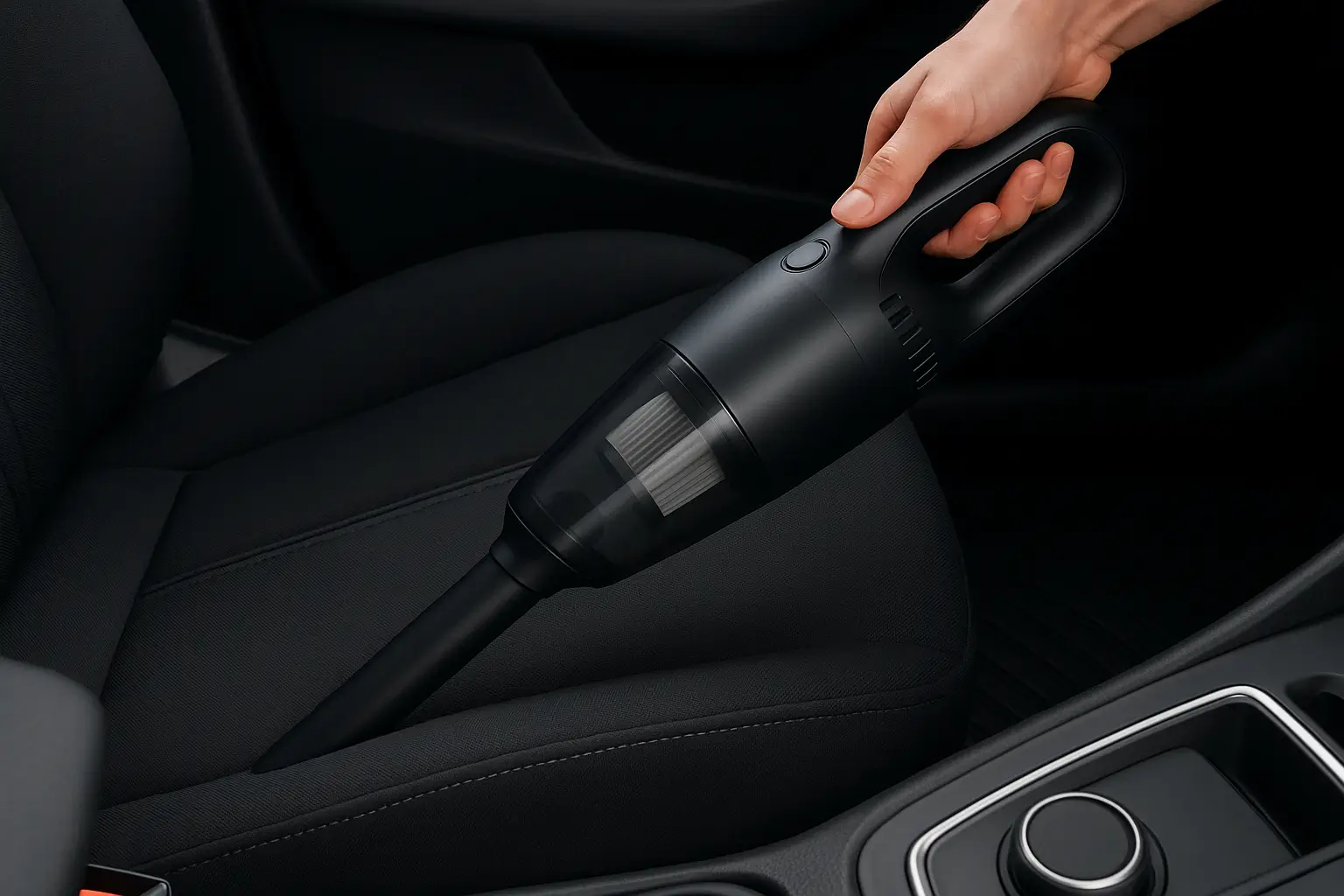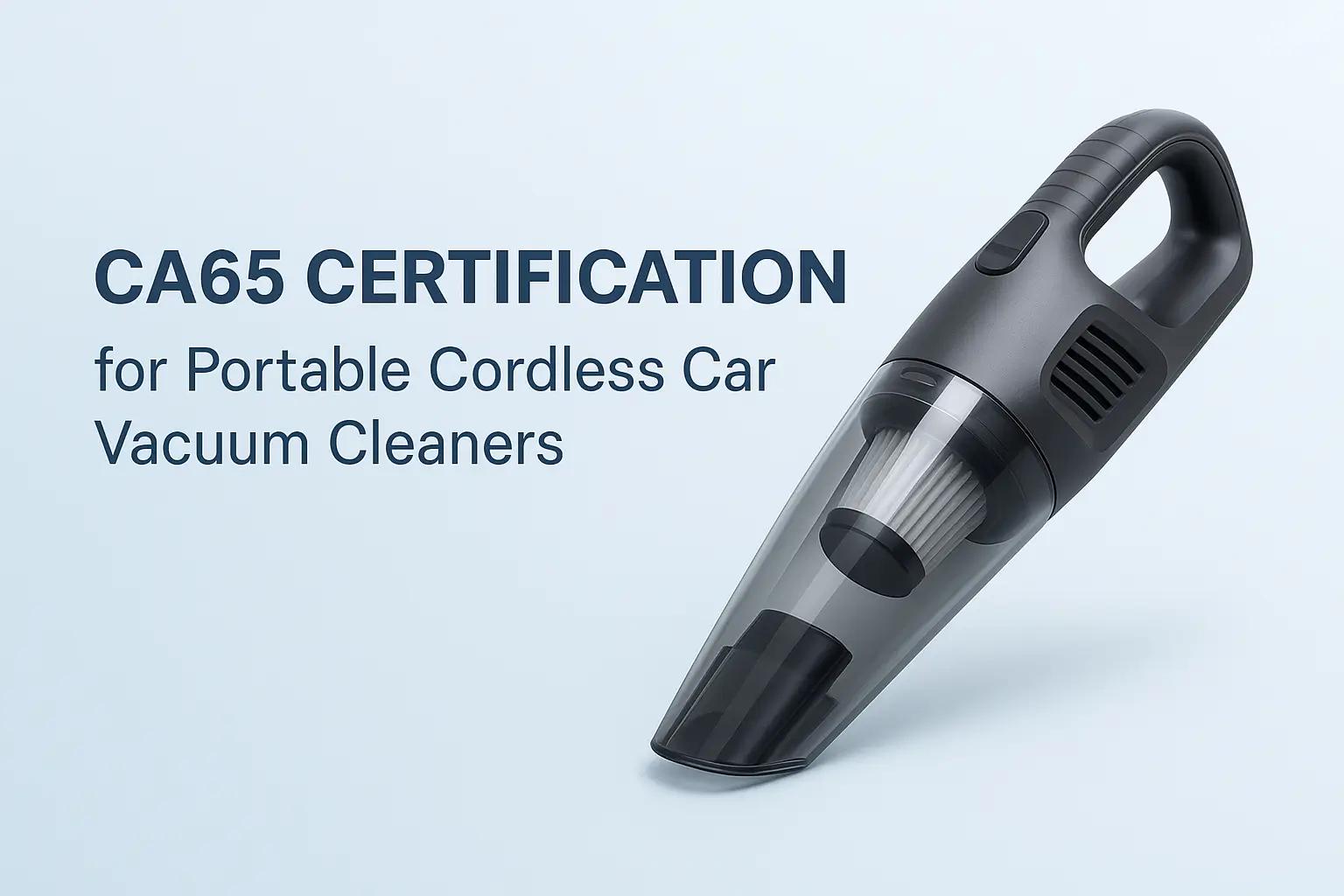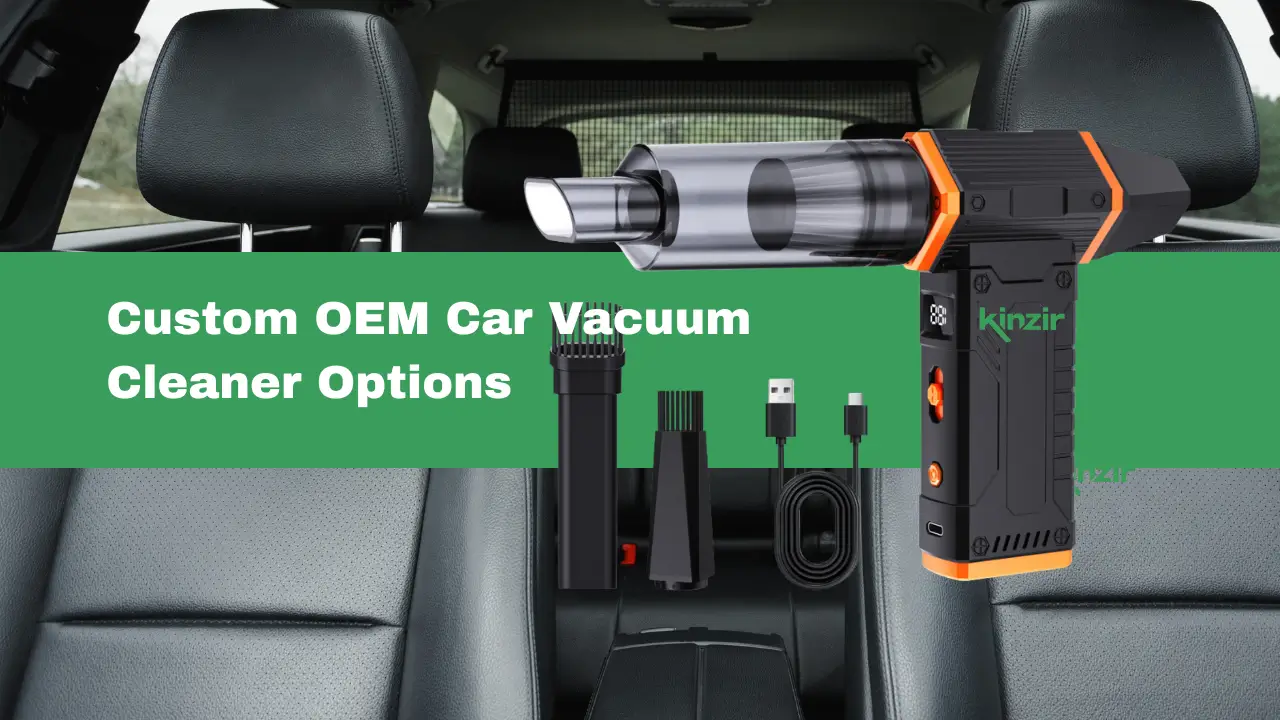Car owners frequently debate whether investing in a dedicated car vacuum is worthwhile compared to other cleaning methods. Understanding the pros and cons of a car vacuum helps you make an informed decision about maintaining your vehicle’s interior cleanliness and resale value. Kinzir, the leading mini wireless rechargeable car vacuum cleaner manufacturer in China, has seen growing demand as more drivers recognize the benefits of portable cleaning solutions.
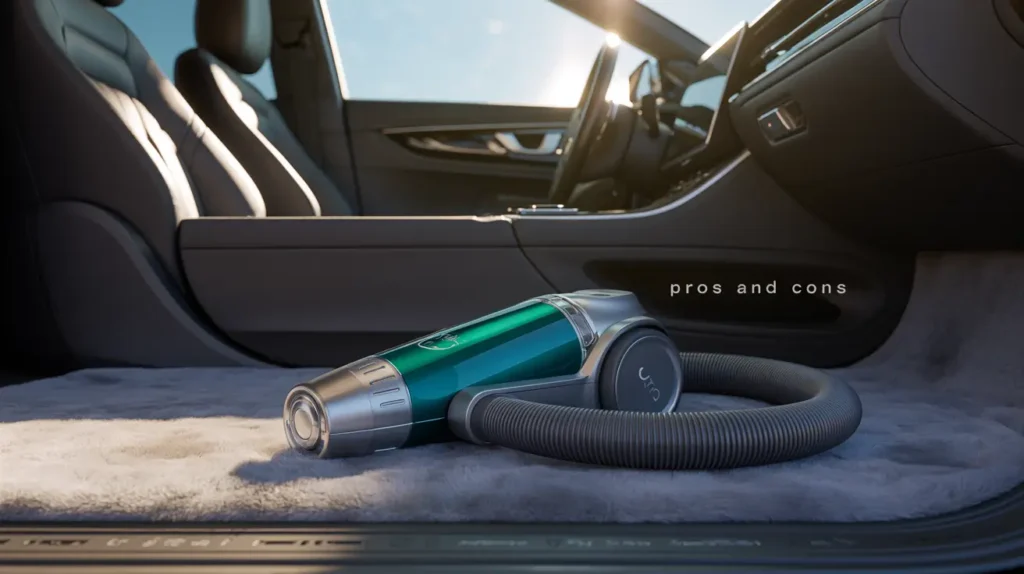
Car vacuums offer convenience and targeted cleaning power, but they also come with limitations in suction strength and battery life. Your choice depends on factors like your cleaning frequency, vehicle size, and budget constraints.
This guide examines the advantages and disadvantages of car vacuums, along with essential features to consider and alternatives that might suit your needs. You’ll discover practical tips for maximizing effectiveness and learn when a car vacuum makes the most sense for your situation.
Benefits Of Using A Car Vacuum
Car vacuums deliver targeted cleaning power that removes embedded dirt, reaches narrow spaces, and maintains healthier cabin air. They provide immediate cleaning solutions while reducing long-term maintenance costs.
Effective Removal Of Dust, Crumbs And Pet Hair
Car vacuums excel at extracting various debris types that accumulate in vehicle interiors. The suction power targets fine dust particles that settle into fabric fibers and carpet weaves.
Crumb removal becomes effortless with proper vacuum attachments. Food particles from snacks and meals get pulled from seat cushions and floor mats without spreading debris around.
Pet hair extraction benefits significantly from car vacuum technology. The rotating brush attachments grab stubborn fur from upholstery surfaces where lint rollers fail.
Different debris types require specific approaches:
- Fine dust: Use broad nozzles with steady passes
- Food crumbs: Apply concentrated suction to affected areas
- Pet hair: Combine brush attachments with multiple directional passes
Your vacuum’s motor strength determines extraction effectiveness. Models with 4-6 peak horsepower handle embedded debris better than lower-powered units.
Access To Tight Crevices With Specialized Nozzles
Specialized nozzles transform car vacuums into precision cleaning tools. Crevice attachments reach between seat cushions where loose change and small items collect.
Upholstery cleaning becomes more thorough with brush nozzles designed for fabric surfaces. These attachments agitate fibers while extracting embedded dirt particles.
Console areas benefit from narrow-tip attachments that navigate around gear shifters and cup holders. Dashboard vents require angled nozzles to remove dust buildup from air circulation systems.
Common nozzle types include:
- Crevice tools: 6-12 inch extensions for narrow gaps
- Brush attachments: Soft bristles for delicate surfaces
- Upholstery nozzles: Wide heads with fabric-safe suction
Door panel cleaning requires flexible attachments that bend around window controls and armrests. These specialized tools prevent scratching while maintaining effective suction power.
Quick Spot Clean-Ups That Save Time Versus Full Detailing
Quick spot cleaning addresses immediate messes without scheduling professional services. Spilled coffee or tracked-in mud gets removed within minutes of occurrence.
Cordless car vacuum advantages include instant availability and no setup time. You can address fresh stains before they set into fabric or carpet fibers.
Emergency cleaning situations benefit from portable units stored in your garage or trunk. Pet accidents, food spills, or muddy footprints require immediate attention to prevent permanent staining.
Time comparisons show clear advantages:
- Spot cleaning: 5-10 minutes
- Professional detailing: 2-4 hours plus scheduling
- DIY full cleaning: 1-2 hours plus preparation
Regular spot maintenance prevents deep cleaning needs. Weekly quick cleanups maintain appearance between monthly thorough cleaning sessions.
Better Cabin Air Quality By Cutting Down Allergens
Allergen reduction improves significantly with regular car vacuuming. Dust mites, pollen, and pet dander accumulate in fabric surfaces and air circulation systems.
Vacuum for allergy sufferers provides immediate relief from airborne irritants. HEPA filtration systems capture particles as small as 0.3 microns during extraction.
Interior cabin air quality benefits from reduced particulate matter. Clean surfaces prevent allergens from becoming airborne when doors close or air conditioning activates.
Specific allergen targets include:
- Pollen from outdoor exposure
- Pet dander from animal passengers
- Dust mites in fabric upholstery
- Mold spores from moisture buildup
Impact on air quality inside car becomes noticeable within days of thorough vacuuming. Respiratory comfort improves for passengers with sensitivities to environmental allergens.
Long-Term Cost Savings Compared With Frequent Professional Cleaning
Long-term cost savings accumulate through reduced professional cleaning frequency. A quality car vacuum pays for itself within 8-12 professional cleaning sessions.
Professional detailing costs range from $75-150 per session depending on vehicle size and service level. Monthly professional cleaning totals $900-1,800 annually.
Portable car vacuum pros and cons show clear financial advantages despite initial investment. Quality units cost $50-200 but provide years of cleaning capability.
Cost breakdown comparison:
| Cleaning Method | Initial Cost | Annual Cost | 5-Year Total |
|---|---|---|---|
| Professional Monthly | $0 | $1,200 | $6,000 |
| Car Vacuum + Quarterly Professional | $150 | $300 | $1,650 |
Car hygiene maintenance becomes affordable with personal vacuum ownership. You control cleaning frequency and thoroughness without hourly service charges.
Drawbacks Of Using A Car Vacuum
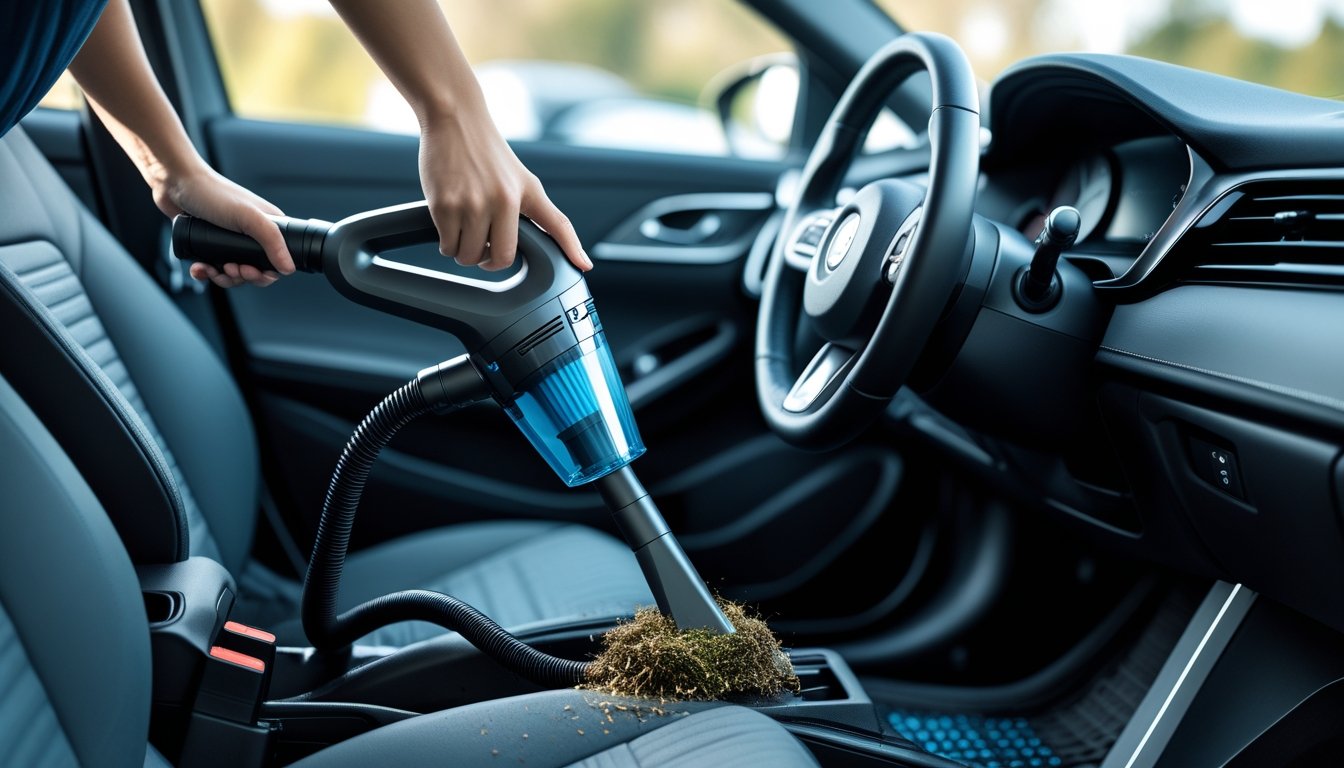
Car vacuum drawbacks include significant upfront costs for quality units, operational limitations from power sources, and ongoing maintenance requirements. These devices also generate considerable noise and require frequent emptying due to compact dust compartments.
Upfront Investment For A High-Quality Unit
Quality car vacuums require substantial initial spending to achieve satisfactory cleaning performance. Budget models under $50 often lack sufficient suction power for embedded dirt and debris.
Professional-grade units typically cost $150-$400 but provide the motor strength needed for thorough cleaning. This upfront investment becomes more expensive when you factor in replacement parts and accessories.
Cost breakdown for quality car vacuums:
- Basic handheld units: $75-$125
- Corded models with attachments: $100-$200
- High-performance cordless vacuums: $200-$400
- Replacement filters: $15-$30 annually
- Additional attachments: $20-$50
Cheaper alternatives often fail within months, making the initial cost savings misleading. You end up spending more through repeated purchases rather than investing in a durable unit upfront.
Runtime Or Cord-Reach Limits That Can Interrupt Cleaning
Battery-powered car vacuums typically provide 15-25 minutes of continuous operation before requiring recharging. This runtime degradation becomes more pronounced as batteries age, reducing cleaning sessions to 10-15 minutes.
Corded car vacuum disadvantages include mobility restrictions based on power source proximity. Standard 12-foot cords limit your cleaning radius and may not reach all vehicle areas from a single outlet position.
You must frequently reposition the vacuum or use extension cords, which adds complexity to the cleaning process. Cord reach limitations become particularly problematic when cleaning large vehicles or working in areas without convenient power access.
Battery replacement costs $40-$80 for most cordless models. Performance drops significantly when batteries reach 70% of original capacity, typically after 2-3 years of regular use.
Small Dust-Bin Capacity Requiring Repeated Emptying
Car vacuums feature compact dustbin capacity ranging from 0.3 to 1.2 liters compared to household units with 2-4 liter capacities. This limitation requires multiple emptying cycles during single cleaning sessions.
Heavy debris like sand, gravel, and pet hair quickly fills small compartments. You must stop cleaning every 3-5 minutes to empty the bin when tackling heavily soiled vehicles.
Typical dustbin capacities:
- Handheld models: 0.3-0.6 liters
- Corded car vacuums: 0.8-1.2 liters
- Wet/dry car vacuums: 1.0-1.5 liters
Frequent emptying interrupts your cleaning rhythm and extends total cleaning time. Fine particles often become airborne during bin emptying, creating additional cleanup requirements.
Regular Filter Maintenance To Keep Performance Optimal
Filter maintenance car vacuum requirements include weekly cleaning and periodic replacement to maintain suction power. Neglected filters reduce performance by 30-50% and can damage motor components.
Filter clogging issues occur rapidly when vacuuming fine dust, pet hair, and debris without proper maintenance. HEPA filters require gentle washing and complete drying between uses to prevent mold growth.
You must purchase replacement filters every 6-12 months depending on usage frequency. Pre-filters need cleaning after each use, while main filters require deep cleaning weekly.
Filter maintenance schedule:
- Pre-filter: Clean after each use
- Main filter: Deep clean weekly
- HEPA filter: Replace every 6-12 months
- Foam filters: Replace every 3-6 months
Clogged filters cause overheating risks and permanent motor damage. This maintenance adds ongoing time and cost to car vacuum ownership.
Noise Levels That May Be Disruptive In Shared Spaces
Car vacuums generate 75-85 decibels during operation, comparable to heavy traffic or lawn mower noise. This noise level car vacuum output makes cleaning disruptive in residential areas, parking garages, and shared spaces.
Early morning or late evening cleaning becomes problematic due to noise pollution concerns. Apartment dwellers and townhouse residents face restrictions on when they can use these devices.
Motor noise increases significantly as filters become clogged or components wear down. High-performance models produce louder operation due to powerful motors required for effective suction.
Noise level comparison:
- Handheld car vacuums: 75-80 dB
- Corded models: 80-85 dB
- Shop-style car vacuums: 85-90 dB
- Conversation level: 60-65 dB
Prolonged exposure to vacuum noise can cause hearing discomfort during extended cleaning sessions. You may need hearing protection for thorough vehicle cleaning projects.
Key Features For Choosing The Right Model
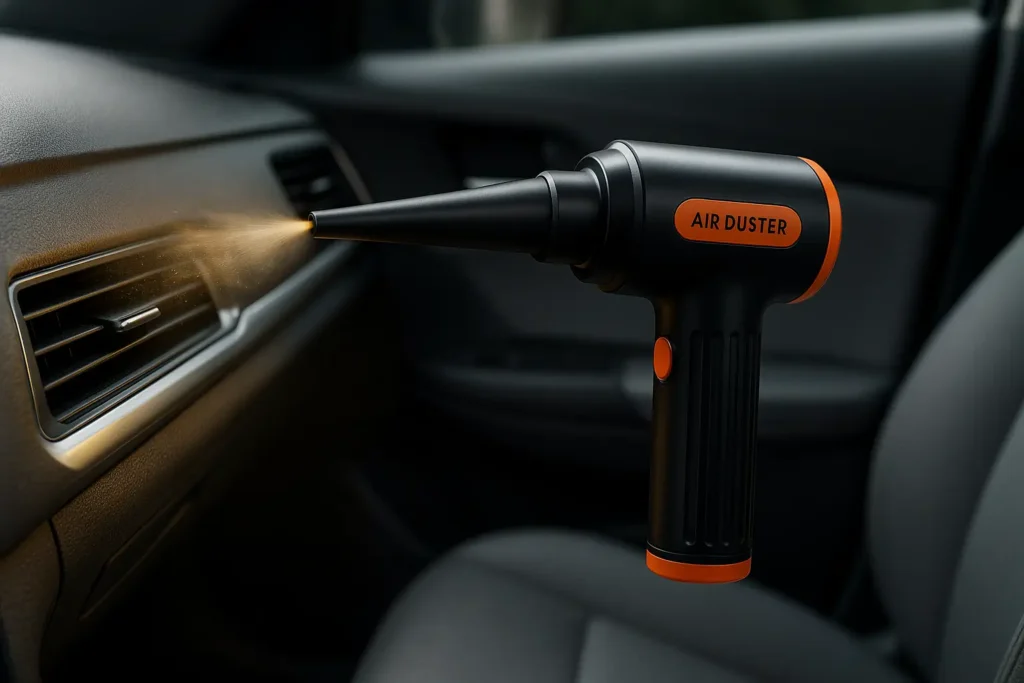
The most critical factors when selecting a car vacuum include suction power ratings, power source type, attachment variety, filtration system quality, physical dimensions, and noise levels. These specifications directly impact cleaning performance and user experience.
Rated Suction Power (Air Watts Or Pascals)
Suction power determines how effectively your vacuum removes debris from car interiors. Manufacturers measure this using air watts (AW), pascals (Pa), or cubic feet per minute (CFM).
Air watts provide the most accurate measurement of actual cleaning performance. Quality car vacuums typically range from 20-60 AW. Models like the Dyson V7 Car+Boat deliver around 21 AW, while corded options can exceed 100 AW.
Pascal measurements indicate static pressure capability. Consumer handheld vacuums usually operate between 4,000-8,000 Pa. Higher pascal ratings help pull debris from deep carpet fibers and tight spaces.
CFM measures airflow volume but doesn’t account for suction strength. You need both adequate airflow and strong suction for optimal performance. The VACLife Cordless Handheld Vacuum combines 6,000 Pa suction with efficient airflow design.
Motor performance affects suction consistency. Brushless motors maintain power longer than brushed alternatives. They also generate less heat and extend battery life in cordless models.
Corded Versus Cordless Operation
Power source significantly impacts vacuum performance and convenience. Corded models provide consistent suction throughout cleaning sessions. The Armor All 2.5 Gallon Car Vacuum delivers continuous power without battery limitations.
Cordless vacuums offer superior portability and eliminate extension cord requirements. Battery runtime typically ranges from 12-30 minutes depending on power settings. The Hoover Air Cordless Car Vacuum provides 20 minutes of fade-free suction.
Battery charging time varies from 2-6 hours between manufacturers. Quick-charge features reduce downtime but may affect battery longevity. Lithium-ion batteries maintain consistent power output until depletion.
Corded shop vacuums excel at heavy-duty cleaning tasks. They handle wet and dry debris without power concerns. The Stanley Wet/Dry Car Vacuum combines 4-horsepower suction with 5-gallon capacity.
Power consumption affects operating costs for corded models. Energy-efficient motors reduce electricity usage while maintaining performance. Consider your typical cleaning frequency when evaluating power requirements.
Range And Design Of Attachment Tools
Attachment variety determines cleaning versatility across different car surfaces. Essential tools include crevice attachments, brush nozzles, and upholstery tools. The Black+Decker Dustbuster includes multiple specialized attachments.
Crevice tool attachments reach narrow spaces between seats and console areas. Length varies from 4-8 inches with optimal designs featuring flexible tips. Rigid crevice tools work better for deep cleaning tight spaces.
Brush nozzle attachments agitate embedded dirt in fabric surfaces. Soft bristles protect delicate materials while stiff bristles handle heavy soiling. Rotating brush heads increase cleaning efficiency on carpeted areas.
Upholstery tools feature wide, flat designs for seat and door panel cleaning. Some models include rubber squeegees for pet hair removal. The Bissell AutoMate includes specialized pet hair tools.
Aftermarket vacuum attachments expand functionality beyond included accessories. Universal fittings allow compatibility across multiple vacuum brands. Specialized car detailing tools target specific cleaning challenges.
Storage solutions keep attachments organized and accessible. Onboard storage prevents lost pieces during cleaning sessions. Some models feature magnetic holders or integrated compartments.
Filtration Type (HEPA, Foam, Cyclonic)
Filtration systems affect air quality and debris capture efficiency. HEPA filter car vacuums remove 99.97% of particles 0.3 microns or larger. This filtration level benefits users with allergies or respiratory sensitivities.
Cyclonic filtration car vacuum systems separate debris using centrifugal force. They maintain suction power longer than traditional bag systems. The Shark Rocket HV292 utilizes advanced cyclonic technology for consistent performance.
Foam filters capture larger particles while allowing airflow passage. They require regular cleaning but offer reusable functionality. Multiple foam layers increase filtration efficiency without restricting airflow.
Washable filters reduce long-term operating costs compared to disposable alternatives. Clean filters monthly or after heavy use sessions. Replacement filters typically cost $10-25 depending on vacuum model.
Pre-motor filters protect internal components from fine dust particles. They extend motor life and maintain suction consistency. Some vacuums feature multiple filtration stages for enhanced air cleaning.
Post-motor filters clean exhaust air before release. This prevents redistribution of allergens and fine particles. HEPA exhaust filtration provides maximum air quality protection.
Weight, Size And Overall Portability
Physical dimensions affect maneuverability and storage convenience. Handheld vacuum cleaners typically weigh 2-5 pounds when empty. Lightweight design reduces fatigue during extended cleaning sessions.
Stick vacuum for car use models range from 4-8 pounds with extended reach capabilities. They access floor areas without requiring awkward positioning. Detachable handheld units provide dual functionality.
Compact storage requirements suit limited garage or closet space. Cordless models eliminate cord storage concerns. Wall-mounting brackets keep vacuums accessible and organized.
Ergonomic handle designs reduce hand strain during operation. Balanced weight distribution prevents wrist fatigue. Soft-grip materials improve control and comfort.
Tank capacity affects cleaning duration between emptying cycles. Larger capacities suit extensive cleaning but increase overall weight. The Kärcher 1.349-230.0 balances capacity with portability.
Space-saving design features include foldable handles and stackable attachments. These innovations maximize storage efficiency in tight spaces. Consider your available storage area when selecting vacuum dimensions.
Audible Output During Operation
Noise levels impact user comfort and neighborhood consideration. Consumer car vacuums typically produce 70-85 decibels during operation. Lower noise measurements indicate quieter performance.
Handheld models generally operate quieter than full-size shop vacuums. Motor design and housing materials affect sound generation. Brushless motors typically produce less noise than brushed alternatives.
Time-of-day usage restrictions may apply in residential areas. Quieter models allow flexible cleaning schedules without disturbing neighbors. Some communities enforce noise ordinances affecting vacuum operation times.
Motor speed settings on variable-power models reduce noise output. Lower speeds decrease volume while maintaining adequate suction for light debris. Maximum power settings provide strongest suction with increased noise.
Sound dampening features include insulated motor hous
Best Practices For Efficient Use
Proper preparation and systematic cleaning order maximize your car vacuum’s effectiveness. Regular maintenance and correct storage extend equipment lifespan while ensuring consistent performance.
Pre-Vacuum Prep: Remove Large Debris And Loose Items
Clear all loose items from your car before starting the vacuum. Remove floor mats, water bottles, papers, and personal belongings from seats, cup holders, and storage compartments.
Pick up large debris by hand first. Coins, wrappers, and food pieces can clog your vacuum or damage the motor. This step prevents blockages and improves suction power.
Empty all compartments including glove boxes, door pockets, and center consoles. Remove seat covers or cushions if possible for thorough cleaning underneath.
Check under seats for forgotten items. Phones, keys, and small toys often hide in these areas and can cause expensive damage if vacuumed up accidentally.
Recommended Vacuuming Order (Seats, Floors, Crevices)
Start with seat fabrics and leather interiors using appropriate attachments. Work from top to bottom to prevent debris from falling onto already-cleaned surfaces.
Vacuum seats thoroughly, including back cushions and headrests. Use the upholstery tool for fabric seats and a soft brush attachment for leather to avoid scratching.
Move to floor areas next. Vacuum floor mats separately outside the vehicle for better access and more effective sand removal and gravel debris extraction.
Finish with tight crevices and detailed areas. Use crevice tools for cup holders, air vents, and gaps between seats. These areas collect the most dust and require focused attention.
Target areas around pedals and under seats last. These zones typically contain the most debris and benefit from the vacuum’s full suction power.
Cleaning Or Replacing Filters On Schedule
Check filters every 3-4 uses for optimal performance. Dirty filters reduce suction power and can damage the motor over time.
Clean washable filters with warm water and mild soap. Allow complete drying for 24 hours before reinstalling to prevent mold growth.
Replace disposable filters according to manufacturer recommendations. Most require replacement every 6-12 months depending on usage frequency.
Monitor filter replacement cost as part of your maintenance budget. Quality filters maintain cleaning efficiency and protect your investment.
Keep spare filters available for uninterrupted cleaning sessions. This prevents delays when filters become too dirty to clean effectively.
Safe Storage And Battery Care (For Cordless Units)
Store cordless vacuums in dry, temperature-controlled environments. Extreme temperatures damage battery cells and reduce overall lifespan.
Charge batteries fully before storage periods longer than 30 days. Partial charges during extended storage can cause permanent capacity loss.
Clean the dust cup after each use for storage convenience. Empty debris prevents odors and maintains hygiene between cleaning sessions.
Store attachments in designated holders or bags. Proper organization prevents loss and damage while maintaining easy access for your next cleaning session.
Avoid storing batteries at full charge for extended periods. Maintain 50-80% charge levels for optimal long-term battery health and performance.
Alternatives And Complements
Car vacuums work well alongside manual cleaning tools like brushes and microfiber cloths for thorough interior maintenance. Compressed air blowers excel at clearing dust from hard-to-reach dashboard vents, while professional services handle deep cleaning tasks beyond typical DIY capabilities.
Manual Tools: Brushes, Microfiber Cloths And Lint Rollers
Manual brushing tools complement your car vacuum by loosening embedded dirt and debris before suction. Detailing brushes with soft bristles work effectively on fabric seats and carpets without causing damage.
Microfiber cloth cleaning handles surfaces where vacuums struggle. These cloths capture dust particles on dashboards, door panels, and console areas through static attraction. You can use them dry for dusting or slightly damp for sticky residues.
Lint rollers remove pet hair and fabric fibers from upholstery more efficiently than some vacuum attachments. The adhesive sheets grab stubborn hair that vacuum suction often misses.
| Tool | Best Use | Cost Range |
|---|---|---|
| Detailing brushes | Fabric seats, carpets | $5-15 |
| Microfiber cloths | Hard surfaces, dusting | $10-20 for pack |
| Lint rollers | Pet hair removal | $3-8 |
These manual tools cost significantly less than electric vacuums and require no power source.
Compressed-Air Blowers For Dust In Vents
Compressed air dusters excel at dash vent vacuuming tasks where traditional vacuum attachments cannot reach. The pressurized air forces dust particles out of narrow vent slats and intricate dashboard crevices.
You can use canned compressed air or electric air blowers for this application. Electric blowers provide consistent pressure and prove more economical for regular use than disposable cans.
The air pressure dislodges accumulated dust that settles deep within your vehicle’s ventilation system. This method works particularly well for clearing pollen, dust, and small debris from air conditioning vents.
Technique matters when using compressed air. Hold the nozzle 6-8 inches from vents to avoid damaging delicate components. Always blow debris toward areas you can easily vacuum afterward.
Professional Detailing Services For Deep-Clean Jobs
Professional detailing services handle intensive cleaning tasks beyond typical DIY car maintenance capabilities. These services use industrial-grade equipment and specialized products unavailable to most consumers.
Professional vs DIY cleaning becomes relevant for heavily soiled interiors, odor removal, and stain treatment. Detailing professionals have steam cleaners, extraction equipment, and enzymatic cleaners that surpass home vacuum performance.
Car detailing services typically include complete interior shampooing, leather conditioning, and protective treatments. The equipment they use generates stronger suction and heat than consumer vacuums.
Cost considerations range from $100-300 for full interior detailing depending on vehicle size and condition. This option makes sense for annual deep cleaning or addressing specific problems like pet odors or significant staining.
Professional services save time and deliver results that manual tools and standard vacuums cannot achieve.
Final Thoughts
Car vacuums offer convenient at-home cleaning with varying power levels and features, while requiring upfront investment and storage space. Your choice depends on balancing cleaning frequency, budget constraints, and specific vehicle needs.
Overview Of Key Advantages And Limitations
Key advantages include immediate access for quick cleanups and long-term cost savings compared to professional services. You control the cleaning schedule and avoid waiting times at car washes.
Portable models offer flexibility for tight spaces and outdoor use. Corded versions provide consistent power for thorough cleaning sessions.
Main limitations center on suction power compared to professional equipment. Most consumer models struggle with deep carpet cleaning and fine debris removal.
Storage requirements and cord management create practical challenges. Battery-powered units need regular charging and eventual battery replacement.
Environmental impact varies by model type. Electric units consume energy but eliminate disposable cleaning products. Professional services often use more water and chemicals per cleaning session.
Your car’s resale value benefits from regular maintenance, though professional detailing provides deeper cleaning results.
How To Weigh Features And Budget For Your Needs
Budget considerations range from $30 handheld units to $150 shop vacuums. Price vs. value depends on your cleaning frequency and vehicle size.
Weekly cleaners benefit from corded models with stronger suction. Occasional users find handheld units sufficient for basic maintenance.
Energy consumption affects operating costs. Corded models use 3-12 amps during operation. Battery units require 2-4 hours charging time.
Compare costs against professional cleaning services averaging $50-100 per visit. Your vacuum pays for itself after 3-5 uses.
Feature priorities should match your specific needs:
- Pet owners: HEPA filtration and specialized attachments
- Large vehicles: Extended hoses and high capacity
- Apartment dwellers: Compact storage and quiet operation
Frequently Asked Questions
Car vacuum buyers often focus on power specifications, battery life, and suction capabilities when making purchasing decisions. Consumer feedback highlights reliability concerns and maintenance requirements as key decision factors.
What are the primary benefits and drawbacks of cordless car vacuums?
Cordless car vacuums offer complete mobility without power cord limitations. You can reach all vehicle areas including trunk spaces and tight corners easily.
Battery life typically ranges from 15-30 minutes per charge. This creates time pressure during cleaning sessions and may require multiple charging cycles for thorough cleaning.
User reviews frequently mention reduced suction power compared to corded models. The convenience factor often outweighs this limitation for quick cleanups and regular maintenance.
How do car vacuums compare with regular vacuums in terms of power and efficiency?
Car vacuums typically produce 20-100 watts of power versus 500-1500 watts for household vacuums. This significant difference affects deep cleaning performance on embedded dirt and debris.
Specialized car vacuum attachments work better for automotive surfaces. Crevice tools and brush heads designed for upholstery provide more effective cleaning than standard vacuum accessories.
Regular vacuums require extension cords and may struggle with automotive-specific cleaning challenges. Car vacuums sacrifice raw power for portability and targeted functionality.
What should be considered when choosing a car vacuum for detailed interior cleaning?
Suction power ratings above 4000 PA provide adequate performance for most automotive cleaning tasks. Lower ratings may struggle with pet hair and ground-in dirt.
Wet/dry capability adds versatility for spill cleanup and moisture removal. This feature appears in higher-end models and receives positive mentions in user reviews.
Attachment variety directly impacts cleaning effectiveness. Look for crevice tools, brush heads, and extension hoses in your online vacuum buying guide research.
What are the longevity and maintenance implications of using a car vacuum regularly?
Filter replacement schedules vary from monthly to quarterly depending on usage frequency. HEPA filters cost $10-25 for replacement sets and maintain optimal suction performance.
Battery degradation occurs after 200-500 charge cycles in most models. Lithium-ion batteries typically last 2-3 years with regular use before requiring replacement.
Warranty and support coverage ranges from 1-3 years across major manufacturers. Extended warranties often cover battery replacement and motor repairs beyond standard coverage periods.
How does the suction power of a 12v car vacuum cleaner stand against other models?
12V car vacuums draw power directly from vehicle outlets and provide consistent performance. These models typically produce 3000-6000 PA suction without battery limitations.
Corded 12V models outperform most cordless units in sustained cleaning power. The direct power connection eliminates battery fade during extended cleaning sessions.
User reviews and ratings show 12V models score higher for deep cleaning capability. The trade-off involves cord management and limited mobility compared to battery-powered alternatives.
What do consumer reports suggest about the reliability of handheld vacuums for vehicles?
Consumer reports indicate 65% satisfaction rates for handheld car vacuums across major brands. Reliability issues center on battery life degradation and motor failure after 18-24 months.
User reviews frequently cite suction power decline as the primary long-term concern. Models with replaceable batteries receive higher reliability ratings than sealed battery units.
Warranty claims spike around the 18-month mark for most handheld models. Premium brands with comprehensive warranty and support programs show better long-term reliability scores.

